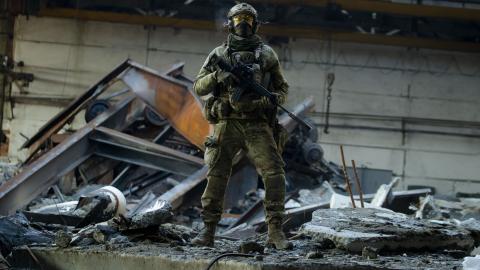This report first appeared as a part of Hudson's Re: Ukraine newsletter series. To subscribe, click here.
Below Hudson Senior Fellow Can Kasapoğlu offers a military situational report about the war in Ukraine.
1. Russian Aircraft Targeted Near Minsk
This week, Belarusian opposition media reported that anti-regime partisans targeted a Russian Beriev A-50 aircraft stationed at the Machulishchy air base near Minsk. Telegram sources suggested the perpetrators attacked the base using drones carrying explosives.
These reports are plausible given known intelligence about Russian assets in Belarus. Russian Aerospace Forces have deployed a Beriev A-50 for joint aerial drills with the Belarusian Air and Air Defense Forces. Moreover, open-source satellite imagery spotted the aircraft in question in Machulishchy in late February 2023. The air base also hosts other important Russian assets like the MiG-31K interceptor aircraft equipped with Kinzhal hypersonic missiles.
If these unconfirmed reports are true, Russia has a problem, a grim one. Beriev A-50s are critical intelligence-gathering assets for the Russian military due to their high-end airborne early-warning and wide aerial-surveillance capacities. Further, the A-50’s look-down radar, which generates a comprehensive air-picture over deep Ukrainian territory, is indispensable for an environment in which Ukrainian pilots often fly low to avoid ground-based radars of the Russian surface-to-air missile systems and Russian air-superiority aircraft. The A-50’s sensor edge also plays an important role in defending against Ukraine’s growing standoff strike capabilities, such as the modified Soviet-manufactured Tu-141 drones. Moreover, according to defense databases, Russia has only ten A-50 aircraft in its arsenal. It could therefore ill afford the loss of a rare commodity at a time when it is most needed.
The purported identity of the saboteurs adds a further complication. Should anti-Lukashenko Belarusian partisans indeed be responsible—especially if the attack was coordinated with the pro-Kyiv Belarusian armed groups fighting in Ukraine—then Putin and Lukashenko might be facing more serious problems than they had estimated.
2. Hard Fighting Continues in Bakhmut
The town of Bakhmut this week has seen some of the fiercest combat since the outset of the conflict, featuring clashes between small detachments, sometimes within areas of operations only a few hundred meters wide. Small villages have changed hands multiple times within days, testing the limits of open-source defense intelligence.
Nonetheless, at the time of writing Wagner forces were stalking the northern outskirts of Bakhmut, only a few kilometers from the town center. The belligerents’ assessments of the military situation drastically differ, but a careful comparison of Russian and Ukrainian sources confirms a heightened operational tempo. Across the northern and southern tips of the Russian encirclement effort, the gap seems to be closing in favor of the Russian combat formations. Should the Ukrainian military be unable to mount a successful counteroffensive while simultaneously keeping its supply routes open, Bakhmut may eventually fall to Russian forces.
3. The End of the Russian Battalion Tactical Group?
Recent developments suggest that the Armed Forces of the Russian Federation have been altering their doctrinal approach to warfighting, replacing battalion tactical groups (BTGs) with more agile and smaller assault detachments. This portends consequences for the future of the conflict, as well as NATO’s defense intelligence calculus about Russia’s military strategy.
The Russian BTG is a combined-arms task force derived from the Russian Ground Forces’ regiment- and brigade-level maneuver units. The Airborne Forces (VDV) and the Russian Naval Infantry also generate BTGs from their regiments and brigades. The BTGs’ doctrinal order of battle is centered on a battalion-sized force of 800 to 1,000 personnel tasked with conducting maneuver warfare and combined-arms operations semi-independently.
Prior to the war, Defense Minister Sergei Shoigu suggested that the Russian military possessed 170 BTGs. The war in Ukraine has exposed their combat deficiencies. The once-vaunted BTG has failed to meet the requirements of large-scale operations in a prolonged interstate war, lacking the tactical flexibility and adaptive edge required for modern warfare.
Thus, Russian military planners have opted for a lighter, more flexible force generation pattern. Reportedly, the new Russian principal tactical unit, the assault detachment, comprises an offensive battalion consisting of two or three companies, each with various components ranging from armor to artillery, as well as support units such as medevac and engineering. Contrary to the proto-Soviet organizational systems of the contemporary Russian military, the assault detachment revolves around tactical flexibility and freedom of movement in small-unit operations, relying on an assault company consisting of several 12 to 15-member platoons. This new formation likely took its inspiration from Wagner’s way of warfighting, marking yet another way in which Wagner has started to build its own doctrinal footprint in the Russian military.
4. Ukraine Considers Its Counteroffensive Options
Ukrainian officials have been strategizing for a southern offensive to be launched sometime in the coming months. Vadym Skibitsky, deputy head of the Ukrainian Main Intelligence Directorate (GUR), stated this week that the Ukrainian military would drive a wedge between Crimea and Russia. Likewise, Ukrainian Chief of General Staff General Valery Zaluzhny stated that the Ukrainians would recapture Mariupol this year.
Unleashing a southern counteroffensive makes military sense. After all, the Ukrainian Armed Forces enjoy better logistics and more favorable lines of communication in the south. Besides, Russian forces in the east have proven more capable of holding ground. In anticipation of a possible Ukrainian offensive, the Russian military has reinforced its fortified positions in the southern sector, including in Crimea and Berdyansk.
Were Ukraine to launch a counteroffensive in the south, its success would be contingent on the Ukrainian Ground Forces’ ability to incorporate Western heavy-armor transfers, and on the Ukrainian Air Defense Forces’ ability to provide ground units with adequate cover when advancing. Besides, Ukraine’s ability to strike the Russian rear to disrupt logistics and command-control nodes will also be a winning factor. Ukraine has to check these boxes for any offensive to be decisive.
Cutting deep into Russian-held territory would also require the rapid collapse of Russian lines of defense and a subsequent disorganized retreat. With a large-scale southern operation depending upon the logistically difficult crossing of the Dnieper, this cannot be guaranteed. The prolonged conflict in Bakhmut, with its ever-increasing casualty count, would also affect the chances of any offensive’s success, not to mention the Russian Federation’s numerical advantage that Kyiv cannot match. After all, for a successful southern counteroffensive, the Ukrainian military would need every single battalion that it can save from the fighting in the eastern sector.
Ukraine still possesses the military might to counterpunch. But it has to overcome many obstacles to do so effectively.
















